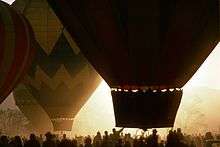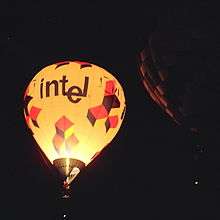Albuquerque International Balloon Fiesta
Coordinates: 35°11′46″N 106°35′51″W / 35.19611°N 106.59750°W

The Albuquerque International Balloon Fiesta is a yearly festival of hot air balloons that takes place in Albuquerque, New Mexico, USA during early October. The Balloon Fiesta is a nine-day event, and has over 500 balloons each year. The event is the largest hot air balloon festival in the world.[1]
History


The Balloon Fiesta began in 1972 as the highlight of a 50th birthday celebration for 770 KOB Radio. Radio station manager Dick McKee asked Sid Cutter, owner of Cutter Flying Service and the first person to own a hot air balloon in New Mexico, if KOB could use his new hot-air balloon as part of the festivities. The two began discussing ballooning, along with conversation and help from Oscar Kratz, and McKee asked what the largest gathering of hot air balloons to date had been. 19 balloons in England, Cutter replied. Kratz asked "Can we get 19 here?" Cutter agreed to try. He got commitments from 21 pilots, but bad weather kept some of them from arriving in time. The first fiesta ended up as a gathering of 13 balloons on April 8, 1972, sponsored by KOB. The first event was located in the parking lot of the Coronado Center Shopping Mall with 20,000 spectators and with balloonists from Arizona, California, Iowa, Michigan, Minnesota, Nevada and Texas taking part. McKee, Cutter, and Kratz are the three men who had originally started the balloon races.[2] The first fiesta incorporated a "Roadrunner-Coyote Balloon Race" (a "hare-and-hounds" race elsewhere in the world) with 1 balloon being the "Roadrunner" and the others being "Coyote" balloons (the "Roadrunner" balloon was actually emblazoned with likenesses of both Warner Bros. characters). The winner of the race - the "Coyote" that landed closest to the Roadrunner - was Don Piccard of the noted aerostation dynasty, flying a balloon of his company's design and construction (his wife also placed in the race). This race has continued as part of the Balloon Fiesta today.
The next year Albuquerque hosted the first World Hot-Air Balloon Championships in February and the fiesta became an international event. In 1975 Albuquerque was looking at hosting the World Championships again, but the event was scheduled for October. So the fiesta was moved to correspond with the championships. To maintain interest in Albuquerque’s bid to host the championships, a balloon rally was held in February of that year. Autumn being a far better flying time than February, the event has remained in early October to the present day.
The Balloon Fiesta grew each year for decades, and today is the largest balloon convention in the world. The number of registered balloons reached a peak of 1,019 in 2000, prompting the Balloon Fiesta Board to limit the number to 750 starting in 2001,[3] citing a desire for "quality over quantity". The limit was changed to 600 in 2009 — citing recent growth in the city and a loss of landing zones. On any given day during the festival, up to 100,000 spectators may be on the launch field where they are provided the rare opportunity to observe inflation and take off procedures. Countless more people gather at landing sites all over the city to watch incoming balloons.
Events



Dawn Patrol
The Dawn Patrol began at the Balloon Fiesta in 1978, when two California balloonists developed position lighting systems that allowed them to fly at night. Dawn Patrol pilots take off before sunrise and fly until it is light enough to see landing sites. Fellow balloonists appreciate the Dawn Patrol because they can watch the balloons and get an early idea of wind speeds and directions at different altitudes.
Mass Ascensions
One of the biggest events of the fiesta, where all participating balloons launch in two waves, filling the sky with hundreds of balloons at once. Launch directors, also known as “zebras” because of their black-and-white-striped outfits, serve as “traffic cops,” coordinating the launch so balloons leave the field in a safe and coordinated manner.
Artistic Vision
Many local artists take advantage of the balloons as favorite subject matter for their paintings. Balloons often land in Albuquerque neighborhoods. Many residents watch the balloons from the comfort of their backyards.
Special Shape Rodeo
Many non-traditional, uniquely shaped balloons are launched at the same time. Some of the most famous shapes include a milk cow, a wagon coach, twin bees, and many others like soda pop cans and animals. This is the most popular part of the event as families can see how balloons can be all different in shapes and sizes.
Balloon Glows
Large numbers of balloons are illuminated at night by their propane burners. They stand static and do not take off during these events. The "Glowdeo" is a night glow for the special shapes balloons.
Special Events and Competitions
Various events like:
- The Fiesta Challenge, a game where balloonists attempt to drop a marker closest to a target.
- America's Challenge Gas Balloon Race, where special long-distance gas balloons are inflated and then launched. The winner of the race is the balloon that travels the farthest. Some balloons in the race have gone as far as Canada and the U.S. East Coast.
- The Flight of the Nations Mass Ascension, where balloonists from each nation launch, one at a time, to their national anthem and waving their nation's flag.
- Other piloting, skill, and speed competitions.
Local impact
The convention has also become a major showcase of New Mexican culture and history and features numerous cultural exhibitions .The fiesta is one of Albuquerque's largest tourist attractions and constitutes a major source of income for the city and local businesses. Typically, tourists and fiesta visitors take thousands of pictures of the balloons, so it is no surprise that for several years the fiesta was sponsored by Kodak and was given the title, the Kodak Albuquerque International Balloon Fiesta, though that title was usually only used in print ads and on official memorabilia.
Albuquerque box

Part of the reason for the success of the Fiesta are the cool Albuquerque morning temperatures in October and the Albuquerque box. The "box" is a set of predictable wind patterns that can be exploited to navigate the balloons. At low elevations the winds tend to be northerly (from the north), but at higher elevations they tend to be southerly. Balloonists use these winds to navigate in a vertical box: they ascend slightly from the launch park, move south, ascend further, move north, descend, and repeat the box or land back in the launch park or quite nearby. During events involving on-field targets, such as the "Key Grab" (where pilots attempt to grab prizes, including a set of keys to a new vehicle, from atop tall, flexible poles), it's not uncommon to see the same balloon make 5 or 6 passes at the targets, simply by working the "Box" to keep returning to the field.
Location
Balloon Fiesta Park, from which the balloons are launched, is located on the northern edge of the city. In 2005, the Anderson-Abruzzo Albuquerque International Balloon Museum was opened on the grounds; it focuses on the last three decades of the festival, and on the history of ballooning.
See also
References
- ↑ Dixon, Chris (July 20, 2007). "Up, Up and Gently Away". The New York Times.
- ↑ Albuquerque International Balloon Fiesta, Albuquerque Hot Air Balloon Rides, Albuquerque Balloon F
- ↑ "2001 Balloon Fissta to Launch an Estimated 750 Balloons". Air Sports International. December 2000. Retrieved 2010-11-04.
External links
| Wikimedia Commons has media related to Albuquerque International Balloon Fiesta. |
- Albuquerque International Balloon Fiesta 2014 Guide
- Albuquerque International Balloon Fiesta official site
- Video Tour of the Albuquerque International Balloon Fiesta
- Albuquerque International Balloon Fiesta article
